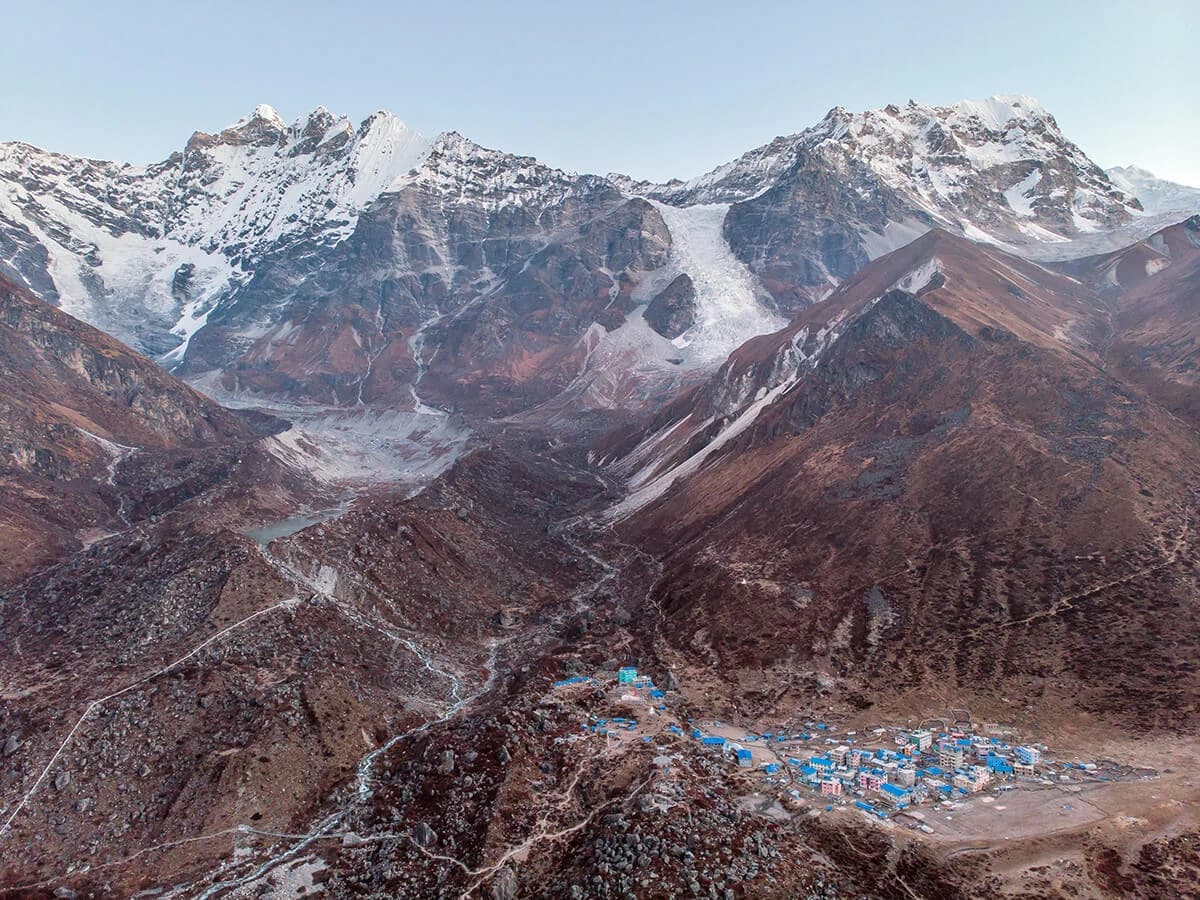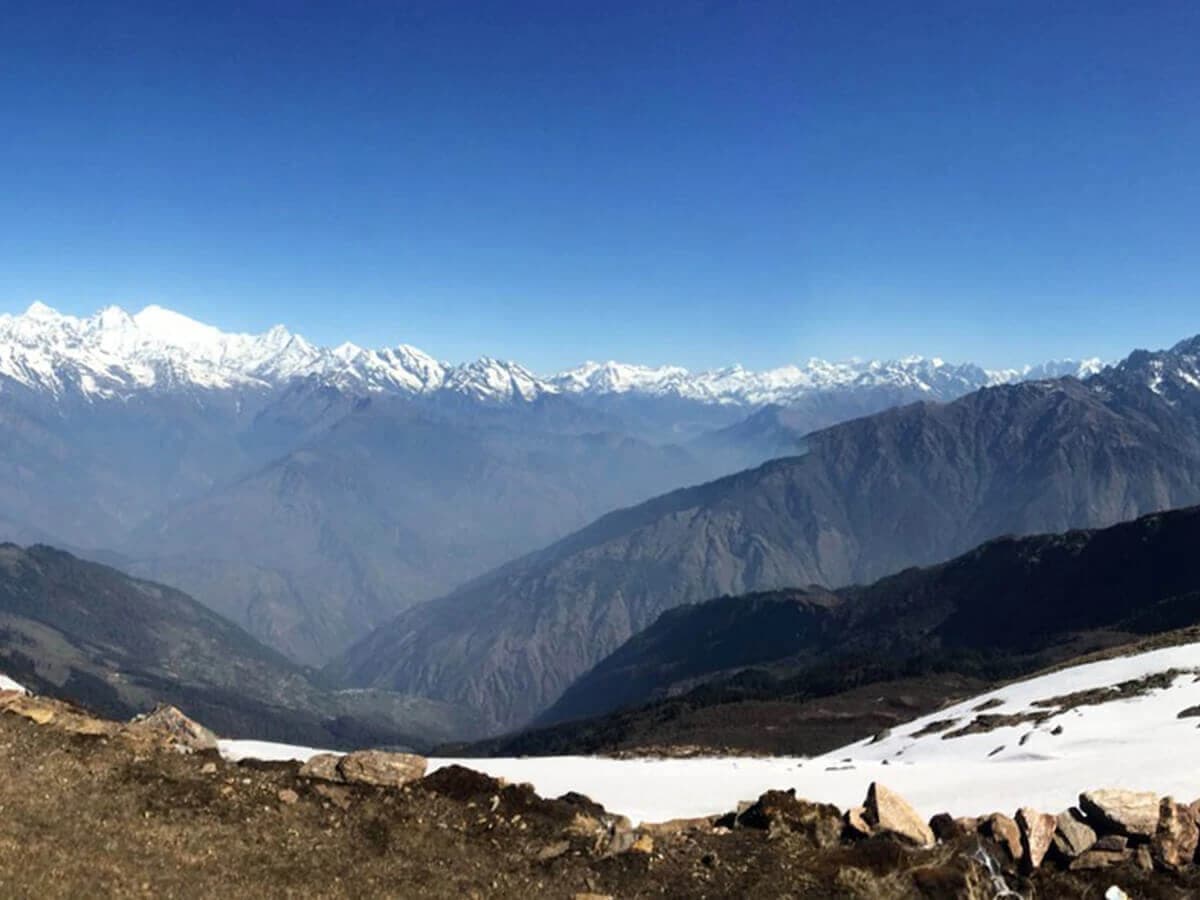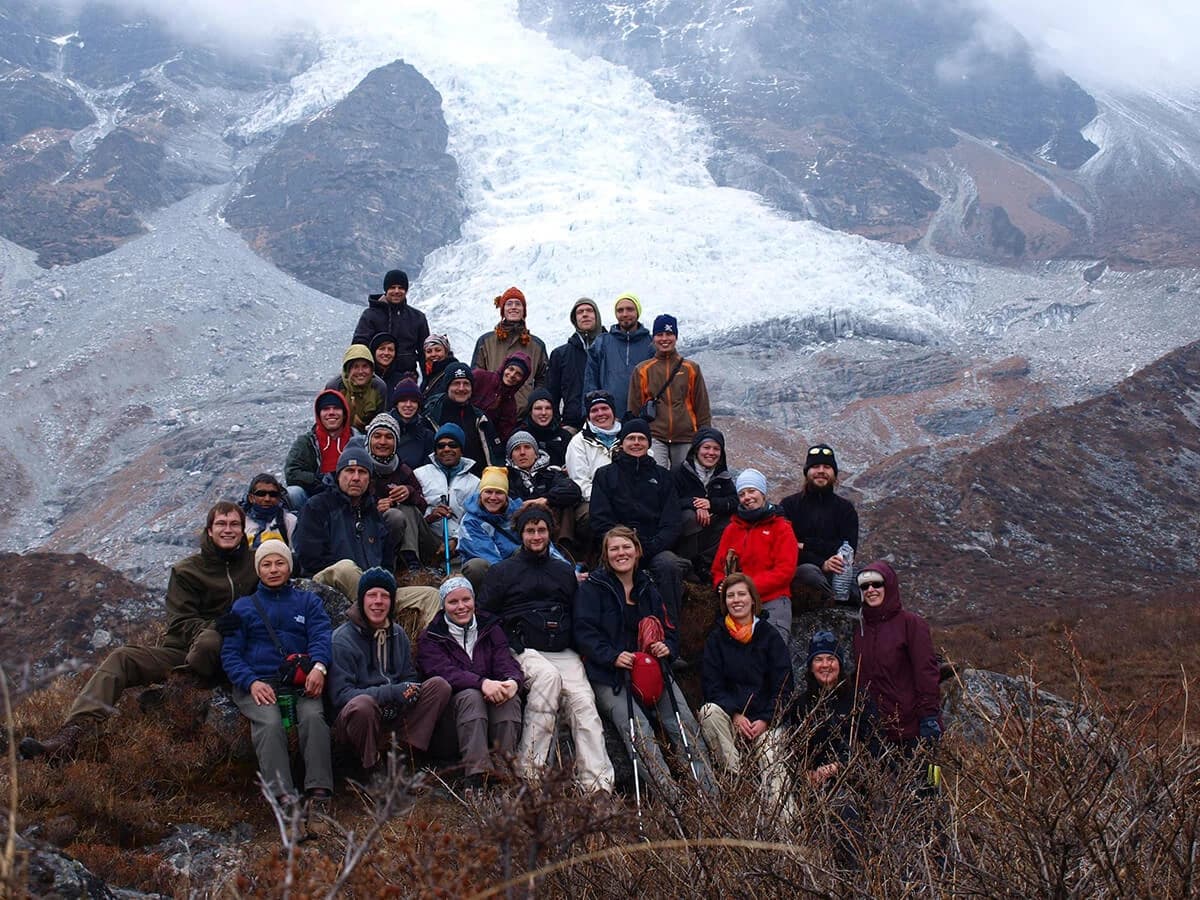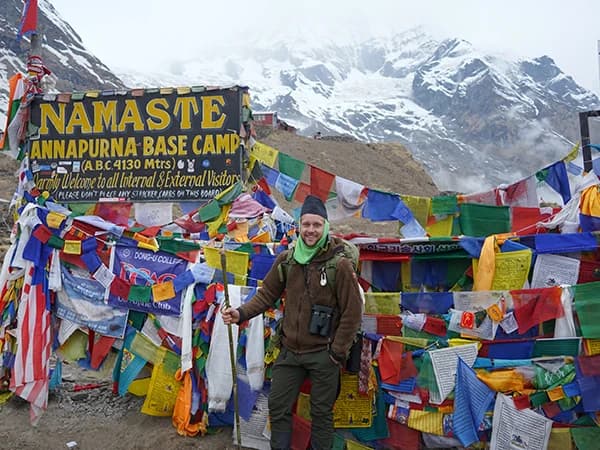A short hike from Kathmandu takes you to the stunning and serene Langtang Valley in Nepal. It provides breathtaking Himalayan views without requiring a strenuous or lengthy hike because it is surrounded by tall mountains and thick forests. Perfect for people looking for a quick hike that combines cultural experiences, peace, and natural beauty.
Langtang Valley Trek - 8 Days
Langtang Valley Trek Overview
The Langtang Valley Trek is one of the most popular trekking routes in the Himalayan region of Nepal. Situated about 80 kilometers north of Kathmandu, the Langtang Valley Trekking Trail also takes you deep into the Langtang National Park, bordering the Tibet Autonomous Region in Southwest China. Also known as the Valley of Glaciers, the Langtang Valley trek in Nepal offers some of the most significant views of the towering Himalayas and jaw-dropping valleys.
This 8-day Langtang Valley trek starts with a scenic drive from Kathmandu to Syabrubesi. Syabrubesi is also known as the entry point of the Langtang region. From Syabrubesi, you will trek along the diverse Himalayan terrain comprising farmlands, lush forests, and alpine meadows, journeying towards Tserko Ri. Along the way, you will find serenity and bliss amid the towering mountains and the crisp Himalayan breeze. There are a few options to extend your trek to the Gosainkunda Lake Trek or the Tamang Heritage Trail.
For the ultimate experience of the Nepal Langtang Valley Trek, book with Global Adventure Trekking. Early bird offers are available for 2026/2027
Nepal Langtang Valley Trek Highlights
- A relatively easy trek into the Langtang Valley in the Rasuwa District of Nepal.
- Start the trip with an adventurous drive covering 122 kilometers through several villages, forests, and the best of nature and tradition.
- A chance to ascend to Tserko Ri, the highest point of the Langtang Valley Trek, situated at an altitude of 5,033 meters above sea level.
- The whole trek will be accompanied by eye-soothing views of sky-towering mountains, including Langtang Lirung, Ganesh Himal, Gang Cheenpo, Naya Kangri, Yala Peak, Dorje Lakpa, and Loenpo Gang.
- This will also be one of the best opportunities to immerse oneself deep into the Tamang culture and the Tibetan heritage.
- On your way through the Langtang Valley Trail, you might also encounter rare animals, including the red panda, the Himalayan black bear, the Ghoral, the grey langur monkey, the Himalayan Thar, the musk deer, and the snow leopard.
- During your ascent, you will also get some time to visit the local cheese factory and the Kyangjin Gompa.
Why Go on the 8-Day Langtang Valley Trekking in Nepal?
Considering the Langtang Trek’s duration and accessibility from Kathmandu, this trek is among the most popular short-duration treks in Nepal. On the 8-day Langtang Valley Trek, you can expect
-
Spectacular Views of Landscapes and the Himalayas
Enjoy breathtaking views of the spectacular Himalayan landscape on the 8-day Langtang Valley Trek. From the towering mountains, including Langtang Lirung, Dorje Lakpa, and Ganesh Himal, to glacial moraines and serene forested trails, this trek takes you close to nature, giving you amazing views along the way.
-
Unique Tamang Cultural Experience
The Tamang people make up almost 80% of the entire Langtang region's settlement. Therefore, going on this trekking journey means taking yourself on a tour of the authentic Tamang culture and settlement. Any trekker visiting this area for the first time can easily be impressed by the unique traditions, culture, practices, customs, and festivals celebrated in this region. Therefore, get ready to witness the most authentic and raw Tamang culture and heritage. Along with that, this region is also close to the Tibetan border. Therefore, you will also get to see the vibes of the Tibetan tradition and culture.
-
Authentic Food and Accommodation
During the Langtang Valley Trek, the trekkers can also get chances to enjoy some of the most authentic food prepared by the locals. While resting in the local accommodation centers and enjoying the meals, you can also chat with the locals of that region. Throughout the trek, you can expect meals three times a day (breakfast, lunch, and dinner). Besides the hotels, guesthouses, and teahouses also offer cozy rooms, comfortable beds, internet, electricity, and hot water services.
Ready to go on the Langtang Trekking adventure? Check out our 2026/2027 departures and see if you’re eligible for last-minute departure discounts. Limited slots available. Book now!
Nepal Langtang Valley Trek Permit Requirements
Trekkers need government-authorized Langtang Valley Trek permits to access the Langtang region. Here are the permits that you must obtain before going for the Langtang Valley Trek:
- Langtang National Park Entry Permit (USD 25) NPR 3000
- Trekkers Information Management System (TIMS) (USD 15) NPR 2000
Booking with Global Adventure Trekking eliminates the hassle of queuing up in government offices in Nepal to obtain your permits. We secure all required permits and present them as required during the trek.
For comprehensive information about the permit and cost, visit our Langtang Valley Permit Cost and Requirements
Trip Gallery
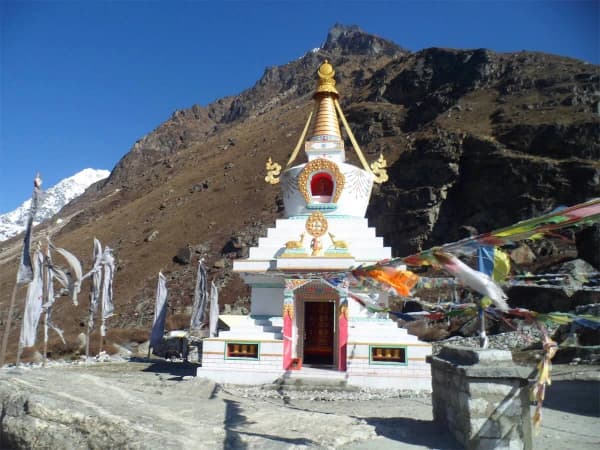
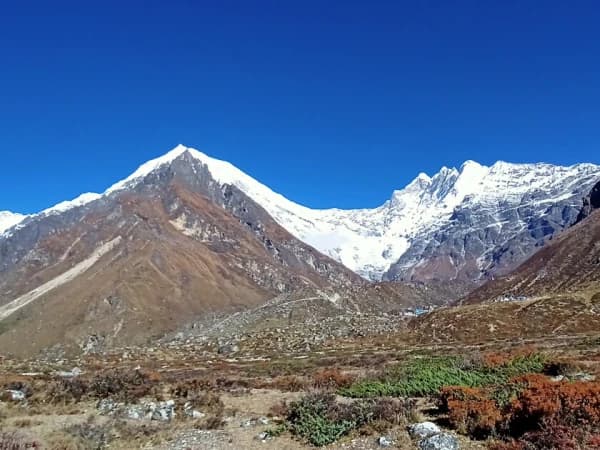
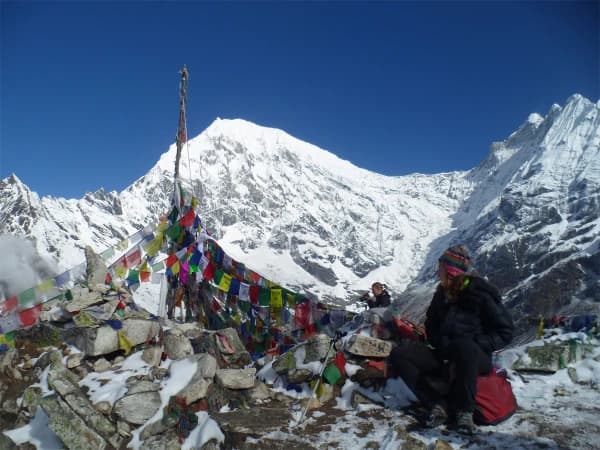

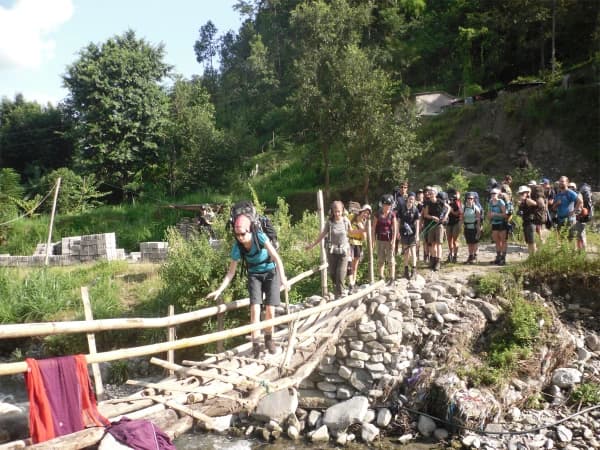
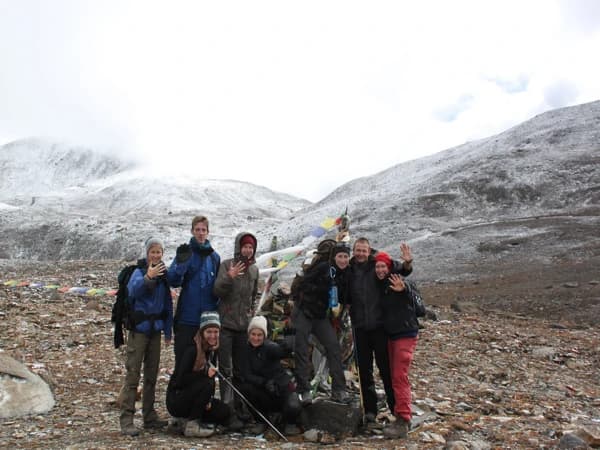
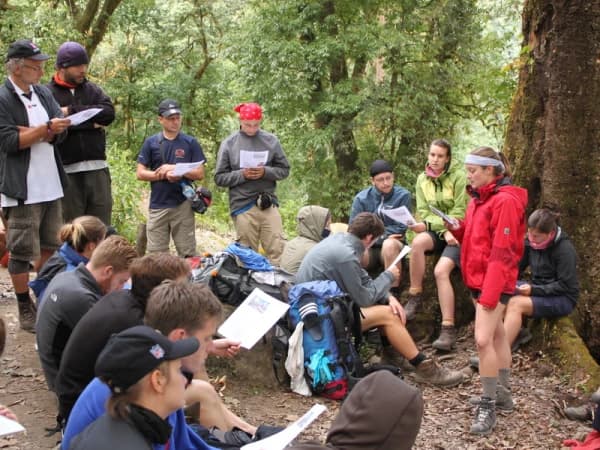
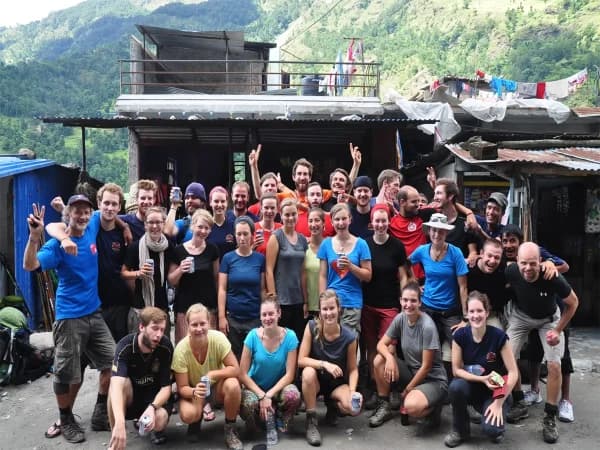
Langtang Valley Trek - 8 Days Itinerary Outline
- Day 01: Kathmandu Drive to Khanjim (2330 m./7,316 ft): 120 km/75 miles/7 -8 hrs
- Day 02: Trek from Khanjim to Lama Hotel (2,380 m./7,830 ft.): 11 km./6 hrs
- Day 03: Trek from Lama Hotel to Langtang Village/Mundu (3,430 m./11,253 ft.): 14 km./ 6-7 hrs.
- Day 04: Trek from Mundu to Kyanjin Gompa (3,870 m/12,697 ft): 7 km./3 hrs.
- Day 05: Explore Kyanjin Ri (4,773 m./15,655 ft.)Tsekuri Ri (5,033 m./16,500 ft.) 8 km. back to Kyanjin Gumpa.
- Day 06: Descend from Kyanjin Gumpa to Lama Hotel (2,380 m./7,830 ft.):22 km./6 hrs
- Day 07: Descend from Lama Hotel to Syabrubesi (1,550 m./5,100 ft.):33 km./ 5 hrs.
- Day 08: Drive from Syabrubesi to Kathmandu 114 km/70 miles/8 hrs. by public Bus/ sharing Jeep
Langtang Valley Trek - 8 Days Itinerary
Today, your Himalayan adventure begins with a scenic drive from Kathmandu to Khanjim. This 7-8-hour drive starts early in the morning, allowing you to enjoy the scenic beauty along the winding hills, rural villages, and the banks of the Trishuli River. This scenic journey offers your first glimpse of the rural communities and the diverse terrain as you head to Khanjim to begin your incredible Langtang Valley Trek. You will pass through several cities like Trisuli Bazar, Dhunche, and Syabru Bensi.
As you depart from Khanjim, you will officially begin the Langtang Valley trek. After breakfast at your local teahouse, you will ascend through lush rhododendron, oak, and pine forests. You will enjoy walking across the small Tamang settlements, and this is the upper part of the classical Langtang Valley trek route. This new itinerary is ideal to hide the busy trail and enjoy yourself with the stunning views of the mountains and the surroundings. You will stop at Sherpa village for hygienic and organic meals. After your lunch, you will follow the easy and smooth path to Lama Hotel. During this peaceful journey, you will have opportunities for wildlife spotting.
Today’s trek lasts a total of 4 to 5 hours before reaching your overnight destination at the Lama Hotel in a small community surrounded by dense forests.
On the third day, we leave Lama Hotel and ascend towards one of the major settlements of the entire Langtang Valley Trekking map, the Langtang village. Well, let us tell you that this village is also known as Mundu. This section of the trail stretches for about 14 kilometers, and we will have to walk for about 6 to 7 hours on this day. Even though the trail starts with a gradual ascent, we must also go past some steep climbs. Moreover, in this section of the trek on Langtang Valley, you will also pass through several yak pastures and a helipad. Furthermore, the spectacular views of sky-towering mountains make this day even more pleasant and walkable.
As you step into Langtang Village, you find yourself in a beautifully settled Tamang village featuring flat-roofed Tibetan-style homes with elegantly carved wooden windows. Take your time to explore each corner of the village before having dinner and sleeping for the night in the hotel.
On the fourth day, we will only walk for about 3 hours and cover a total distance of 7 kilometers. As this will be a walk to the high altitude of 3,870 meters above sea level, we recommend that the trekkers keep a slow pace. Moreover, we also recommend that trekkers be very careful about the possibility of altitude sickness. Our journey starts through a route with Mani walls on both sides, and on the way, we also cross several prayer flags, moraines, and several small streams.
Within just 3 hours of walking, today's journey comes to an end as we reach the Kyanjin Gompa area. Entering this village offers you a feeling of calmness and peaceful vibes, as this place is home to the significant Kyanjin Gompa. Besides, this last section of the trail offers some spectacular views of glaciers flowing from Kimshug and Langtang Lirung peaks. Take your time to visit the monastery and delve deeper into the Buddhist religion. Other than that, you can also witness the jaw-dropping views of Dorje Lhakpa, Langshisha Ri, Ganja La, Tsergo Ri, and many other mountains from this village. Also, don't forget to interact with the locals of this place to learn more about the Gompa and the settlement. Kyanjin is very famous for Yak cheese.
Get yourself all geared up and be ready because we are about to go for one of the most thrilling and adventurous ascend of the entire Langtang Valley Trekking route. Yes, it's the day when we ascend to Kyanjin Ri and Tserko Ri, the two highest points of the entire Langtang Valley Trekking trail. You can simply choose to go for any one of these two points. Regardless of the option you choose, we start the walk early in the morning because it will be an early sunrise view hike.
Hike to Kyanjin Ri (4,773 meters)
This is the shorter of the two hiking options that we have on the sixth day. It only takes us about 3 hours to reach the top of the Kyanjin Ri viewpoint. This hiking route takes us through a steep but manageable ascent, which will be perfect for your body to adapt to the high-altitude terrain and conditions. The top of this viewpoint offers spectacular sunrise views over Langtang Lirung (7,227m), Yala Peak (5,500m), and Dorje Lakpa (6,990m).
Hike to Tserko Ri (5,033 meters)
Another exciting activity of the day is the quick hike to the Tserko Ri viewpoint, located at an altitude of 5,033 meters above sea level. This hike stands as a rather demanding and challenging one that offers spectacular views of the Langtang range, Shishapangma (8,013m), and even the Tibetan Plateau. Take your time to delve deep into the alpine environment, feel the cool breeze, and make as many photos and videos as possible.
After the entire day of an amazing, challenging, and adrenaline-rushing hike, we return to Kyanjin Gompa again. Upon your return, you will enjoy a delicious and fulfilling breakfast in this village. After that, you can utilize the rest of the day to stroll around the village, interact with the locals, and try some local delicacies. Dinner and overnight stay will be arranged by the GAT team in Kyanjin Gompa.
After almost 5 days of the ascending journey in the Langtang Valley, it's finally time to return from the trekking trail. Therefore, we start the descending walk towards the Lama Hotel on the sixth day. Make sure that you have a proper breakfast before starting the walk because we need to cover almost 22 kilometers on this day. However, as this is a descending walk, the trekkers only have to walk for about 6 hours to reach the Lama Hotel.
On your way to the Lama Hotel, you will again get a chance to walk through the lush rhododendron forests, oak and pine trees and also stop by different traditional villages. As you reach Lama Hotel, once again, check into the same hotel.
Finally, we have come to the last walking day in the 8-Day Langtang Valley Trek, which goes from Lama Hotel to Syabrubesi. Remember Syabrubesi, the starting point of this trekking route? Well, it is also the ending point of the Langtang region. On your way, the trail takes us past lush rhododendron and bamboo forests with potential chances of encountering Red Pandas and wild boar.
Finally, as you reach Syabrubesi, you will check in at the hotel before taking a quick stroll through the village for the last time. In the evening, we invite you for a farewell dinner, which will also be a certificate distribution ceremony. Yes, the Global Adventure Trekking team will provide you with a certificate of accomplishment for successfully covering the 8-day Langtang Valley Trekking map.
Today is the exact reverse of the first day of the Langtang Valley Trek. After breakfast, our guides will take you to the bus station, from where you will board a public bus to Kathmandu. In some time, you will exit the Langtang region and drive on the most impressive and naturally decorated roads through the hills and plains. Within the next 8 hours, we will finally reach Kathmandu. Don't worry, our local representatives will drive you to the hotel as you say, which puts an official end to the 8-Day Trek to Langtang Valley.
Langtang Valley Trek - 8 Days Cost Details
Includes
Transportation
- Kathmandu to Syabrubesi by local bus/local Jeep
- Syabrubensi to Kathmandu by local bus/local Jeep
Langtang Valley Trekking Permit Fees:
- Langtang National Park Entry Permit
- Trekkers Information Management System (TIMS)
Accommodations:
- 6-night best available teahouse accommodation during the trek as per the itinerary
Meals:
- Full-board meals (Breakfast, Lunch, and Dinner)
- Seasonal Fruits
Additional Gear:
- Sleeping bag and down jacket, if required
- Company Duffel Bag and T-shirt
- Langtang Valley Trekking Map
Guides:
- Government-certified, well-experienced Global Adventure Trekking guide
- Salary, including insurance, equipment, accommodation, and food for your Nepalese Guide
Excludes
International Flights and Visa Fees:
- International flights to and from Nepal
- Nepal Entry Visa Fees
Additional Expenses:
- Entry fees or donations, museums, monasteries, while trekking, etc.
Rescue and Evacuation:
- Emergency evacuation by Helicopter
Accommodation and Services:
- Extra-night hotel and food in Kathmandu in case of an earlier return from the mountain than the scheduled date.
- Laundry, towels, hot showers, internet access, recharging of batteries, and other items of a personal nature.
Transportation:
- Alternative transportation in case of heavy rain, landslides, strikes, road blockades, etc.
Meals:
- Meals other than those listed in inclusions (Hot and cold, alcoholic and non-alcoholic drinks)
Guides and Porter Expenses:
- Porters (20 kg max weight limit)
- Tips for the guide and the porter
Add-ons & Options
Upgrade to private transportation:
If you want a comfortable and flexible private ride from Kathmandu to Sybru Bensi, we can provide a private Jeep for an extra cost of USD 150 for a one-way trip. Six people can be comfortably accommodated in the Jeep. Once you finish your trek at Syabru Bensi, you can take either a private Jeep at the same cost or catch a local sharing Jeep.
Hire a Porter:
If you prefer hiring a porter to carry your extra luggage and enjoy your trek, you can hire a porter for an additional cost of USD 20 per day. The cost will cover accommodation, meals, and the daily wages of the porter. Two trekkers can share a porter and split the cost. A porter can carry up to 20/22 kg.
It is highly suggested to hire a porter from a registered trekking company; make sure they are well-equipped and insured.
Dates & Availability
Select your preferred date
If you are looking for a private trip, please let us know by the time of booking. Solo travelers are welcome. The Langtang Valley Trek is easy and short in Nepal. The trek involves about 5–6 hours of walking a day. Moderate physical fitness is required. We are having daily departures.
Essential Information
Best Season for the Langtang Valley Trek
Before setting off on any trek, it's important to know what kind of weather to expect. Choosing the right season for the 8-day Langtang Valley Trek can make a huge difference in your experience. Therefore, we recommend the trekkers to check this section out thoroughly before booking the trek to Langtang Valley.
Spring (March to May) and Autumn (mid-September to November) Season
As the spring and autumn seasons offer clear skies, mild temperatures, and incredible views of the Himalayas along with the best conditions, these seasons stand as the most ideal seasons for the Langtang Valley Trek. Moreover, blooming rhododendrons, lush forests, and vibrant landscapes also surround the whole trekking route, making every step even more enjoyable. Besides, during these peak seasons, most lodges and teahouses remain open. This means you will also have access to better accommodations and a wider variety of food options.
Winter (December to February) Season
If you are someone who enjoys a bit more challenge and adventure, winter (December to February) is the best option. The snow-covered trails and quiet, peaceful surroundings can be truly magical, but the cold temperatures, icy paths, and limited lodge availability make it a tougher trek. Therefore, we recommend the trekkers to stay extra prepared for unpredictable weather and freezing conditions if they plan the trek in the winter season.
Langtang Valley Trek Difficulty Level
The 8-Day Langtang Valley Trek is considered a moderately difficult trek. This trek is an adventurous journey but still suitable for beginners. However, we recommend preparing in advance for a safe and memorable Langtang Valley Trekking in Nepal.
Food and Accommodation during the Langtang Valley Trek
During the Langtang Valley Trek, you will find plenty of food options, especially at lower altitudes. The menus typically feature traditional Nepali dishes like dal bhat (rice and lentils), Newari Thali, and Tibetan specialties. Many teahouses also serve international meals such as pasta, sandwiches, burgers, pizza, momos (dumplings), and chowmin.
The higher altitude regions may have limited food options, but you can still find warm and nutritious food to replenish your energy.
Besides, the Langtang Valley Trekking route also offers teahouses and lodges with clean and cozy accommodations. Furthermore, most of them provide basic amenities like electricity, hot showers, charging ports, and WiFi (though the connection may be spotty at higher altitudes). The rooms are usually twin-sharing with warm blankets to keep you comfortable at night.
As you climb higher, food choices become more limited due to colder temperatures and rugged terrain. However, you can still expect nutritious meals that provide the energy you need for trekking. Besides, warm soups, porridge, and herbal tea are great for keeping your body fueled and hydrated in the cold.
With Global Adventure Trekking, you can enjoy your adventure without worrying about where you’ll sleep or what you’ll eat. We ensure that you get quality food and accommodations so you can focus on the incredible landscapes and experiences awaiting you in Langtang Valley.
Altitude Sickness on the Langtang Valley Trek & How to Prevent It?
The 8-Day Langtang Valley Trek reaches altitudes of nearly 5,000 meters (16,400 feet) above sea level, making altitude sickness a real concern for trekkers. It’s important to understand the symptoms and take the right precautions to stay safe.
Common Symptoms of Altitude Sickness
Altitude sickness often begins when you go above 3,000 meters (9,800 feet). Watch out for these warning signs:
- Headache
- Fatigue and low energy
- Dizziness or nausea
- Loss of appetite
- Difficulty sleeping (insomnia)
- Shortness of breath
If you feel any of these symptoms, it’s crucial to take action immediately to prevent it from getting worse.
How to Prevent & Manage Altitude Sickness?
- Stay Hydrated: Drink at least 1 liter of water for every 500 meters (1,640 feet) you ascend. Staying hydrated helps your body adjust to higher altitudes.
- Avoid Alcohol & Smoking: Alcohol and tobacco can dehydrate you and slow down acclimatization, making altitude sickness worse.
- Eat Carbohydrate-Rich Foods: Eating plenty of carbs helps your body generate energy and adapt to low oxygen levels. Dal Bhat, soups, and high-calorie meals are great choices.
- Use the Acclimatization Day Properly: Spend your rest day at Kyanjin Gompa wisely by taking short hikes to higher elevations before returning to a lower altitude to sleep.
- Pace Yourself: Walk at a slow, steady pace and avoid pushing yourself too hard. Listen to your body and take breaks when needed.
By following these simple yet effective measures, you can reduce the risk of altitude sickness and enjoy the trek without unnecessary health concerns. At Global Adventure Trekking, our guides are trained to identify and handle altitude sickness, ensuring that you have a safe and enjoyable trek to the Langtang Valley.
Langtang Valley Trek Packing List
One of the most crucial things to do while going for any trek, including the Langtang Valley Trek, is to pack smartly. Smart and thoughtful packing makes trekking more convenient and easier. Therefore, we recommend the trekkers to be very careful and smart while deciding what to pack for the Langtang Valley Trek. Here are a few suggestions for smart backpacking during this trek:
Head
- Trekking Hat/Cap
- Headlamp/Flashlight (with extra batteries), good quality
- Sunglasses (UV protection)
- Woolen hat/beanie (for cold weather)
- Bandana/Buff (for dust and sun protection)
- Sunblock (Sunscreen) (SPF 40 or higher)
- Insect Repellent (any trekking areas)
Body
- Base Layer Shirt: Two pairs (moisture-wicking, breathable fabric)
- Trekking Jacket: A pair of lightweight (water-resistant/windproof)
- Insulating Layer: A pair (fleece, down jacket, or sweater for warmth)
- Rain Jacket/poncho (lightweight, waterproof)
- Trekking Trousers/Pants: Two pairs (comfortable and durable)
- Long-sleeve shirt: A pair (for sun or insect protection)
- Underwear: Two pairs (moisture-wicking, quick-dry fabric)
- Compression Garments (for reducing muscle fatigue, optional)
- Gore-Tex Similar Level Jacket
Lower Body
- Trekking Pants: Two pairs (convertible into shorts if needed)
- Thermal Leggings: one (for cold weather)
- Shorts: Two (optional, for warmer weather)
- Knee Guards/Support (for those who need extra knee protection)
Hands
- Light inner gloves (for lower-elevation trekking)
- Insulated or down gloves (high-altitude trekking)
- Waterproof glove (wet season)
Footwear
- Trekking Boots/Shoes (comfortable, waterproof, with good grip and ankle support)
- Gaiters (to protect from mud, snow, or rocks entering boots)
- Thick Socks: Two pairs (merino wool or synthetic, moisture-wicking)
- Lightweight Socks: Two pairs (for warmer weather or layering)
- Sandals/Flip-flops (for campsite/rest stops)
Extra Suggested Items
- Sleeping bag
- Drying towel
- Trekking Poles
- Cash (extra Nepali rupees for additional expenses)
- Backpack (rucksack) with 60 L (with rain cover and hydration system)
- Hydration System/Water Bottles/Camelback
- Water Purification Tablets/Filter
- Snacks (Energy Bars, Dried Fruits, Nuts)
- First Aid Kit (with basics like bandages and antiseptic, as per personal need)
- Multi-tool/Knife
- Trekking Map or GPS
- Portable Power Bank (to charge devices)
- Camera or Smartphone (to capture the views)
- Toiletries (toothbrush, toothpaste, biodegradable soap, shampoo), feminine hygiene products as needed
- Coupons (as needed)
- Emergency Whistle
- Dry bags
- Clothing Layer
- Duct Tape
- Hand sanitizer
- Fire-starting Kit (matches, lighters)
- Plastic Bags for Waste (Leave no trace principle)
- Notebook/Journal (for documenting the trip)
Why Book the Langtang Valley Trek with Global Adventure Trekking?
Global Adventure Trekking takes pride in being your trusted Nepal travel partner. We prioritize safety and cultural immersion on every trek. Our reliable, highly experienced guides and support team ensure an unforgettable Himalayan experience. Furthermore, our years of experience in Himalayan adventures help us deliver results that meet our clients' preferences. With Global Adventure Trekking, you will find:
WINTER OFFER:
Get 10% off on your purchases
Coupon Code: LVT-8 DAYS
Offer Until 01/03/2026
- Seasoned and professional guides.
- Guides and support staff with fluency in English and conversational skills in several other languages.
- Good knowledge of local languages.
- Friendly, helpful, and proper services throughout the trekking itinerary.
- The guides, along with all the staff members of Global Adventure Trekking, approach the trekkers in the most personal way possible. This helps us ensure proper facilities and services for all the individual trekkers.
- Free pre-trek consultation from expert guides
- Flexible booking dates.
- Special offers
- Focus on communal sustainability and economic development of the rural trekking routes. We provide 5% of our total income toward the welfare of rural areas.
If you have any queries or questions regarding the Langtang Valley Trekking package or any other services that we offer, we recommend you contact us via WhatsApp and Viber. Besides, you can also send us the queries via email at info@globaladventuretrekking.com or call us directly at +977 9841527688 (Rajan Dahal). Remember that our team will always be ready to assist the trek and travel enthusiasts.
Langtang Valley Trek - 8 Days FAQs
The trek on Langtang Valley starts and ends in Syabrubesi. However, the actual starting and ending point of the trek is Kathmandu, from where we start with a drive to Syabrubesi and end with a drive from Syabrubesi.
Yes, as the Langtang Valley Trek is a moderately difficult trekking route, this trek is suitable for beginners with basic training, physical fitness, and mental readiness.
As the Langtang Valley Trek is moderately difficult, you might not require prior experience. If you have a good level of fitness and stamina, you can complete the trek comfortably. Regular cardio exercises, hiking practice, and strength training before the trek can help.
Packing appropriately is key to a successful trek. Here’s a basic checklist:
- Clothing: Moisture-wicking base layers, warm fleece/down jacket, waterproof jacket, trekking pants, gloves, and a hat.
- Footwear: Sturdy trekking boots, extra socks, and gaiters for snow.
- Gear: Trekking poles, a headlamp, a sleeping bag (rated for -10°C), a backpack, and a rain cover.
- Accessories: Sunglasses, sunscreen, lip balm, a first aid kit, water purification tablets, and toiletries.
- Essentials: Passport, permits, extra cash (no ATMs on the route).
If an emergency occurs, your guide and trekking team will assist you immediately. Possible actions include:
- First aid and rest for mild conditions like altitude sickness or injuries.
- Descending to a lower altitude if symptoms worsen.
- Helicopter evacuation for serious cases (requires travel insurance with emergency rescue coverage).
- Immediate communication with authorities and hospitals in Kathmandu if necessary.
Yes, travel insurance is highly recommended for the Langtang Valley Trek. It should cover medical emergencies, trip cancellations, and helicopter evacuations up to 5,000 meters. Without insurance, rescue operations can be extremely expensive, so having coverage ensures peace of mind in case of any unexpected situations.
You can bring a drone, but flying it requires permission from Nepal’s Civil Aviation Authority (CAAN) as well as from the Langtang National Park authorities. In some areas, locals may also have restrictions due to privacy and cultural concerns. Therefore, you must be prepared with all the necessary permits.
The Langtang Valley Trek offers breathtaking landscapes, including snow-capped peaks, glaciers, waterfalls, and dense forests. You’ll also experience the unique culture of the Tamang people, who have Tibetan influences in their traditions and architecture. Along the way, you might spot Himalayan wildlife such as red pandas, langurs, and mountain goats.
Yes, Global Adventure Trekking allows cancellations and rescheduling, but policies vary depending on the time of cancellation and availability for rescheduling.
Yes, even though most trekking packages include accommodation and meals, you’ll still need extra cash for personal expenses. Items like snacks, hot drinks, bottled water, WiFi, hot showers, and battery charging often come at an additional cost in teahouses. If you’d like to leave tips for guides and porters, it’s customary to do so at the end of the trek. Since there are no ATMs along the route, withdraw enough cash in Kathmandu before starting your journey.
What Our Clients Say?
Hello!
We’ve just returned from an amazing 8-day Langtang Valley Trek, and we couldn’t be happier! This was our second trek with the Global Adventure Trekking (GAT) Team, and once again, it was a fantastic experience.
Our guide Amir was...
We have just returned from our 8-day Langtang Valley trek and feel very grateful and lucky to have had an excellent guide who arranged everything for us and accompanied us along the 8-day trek in the Himalayas. It was an...
